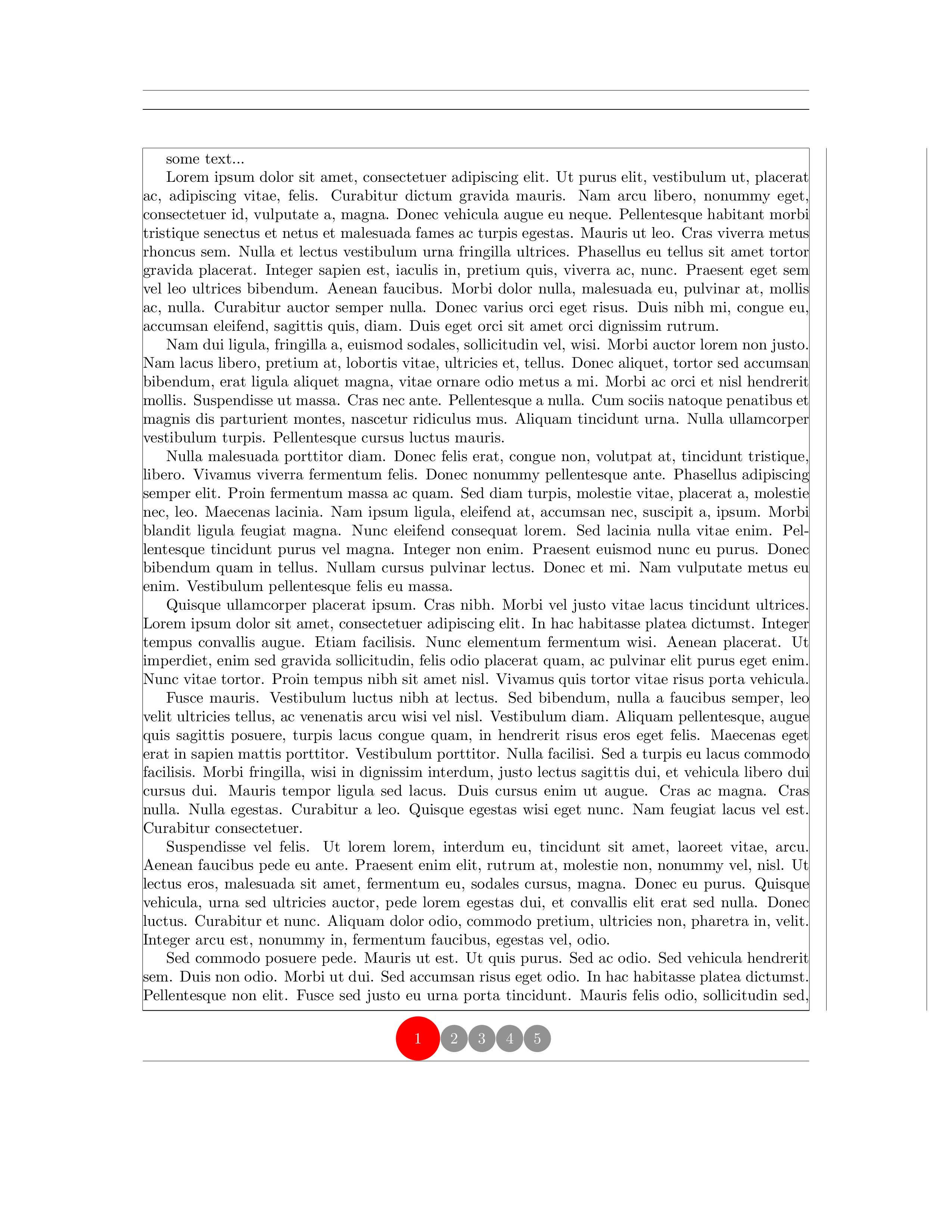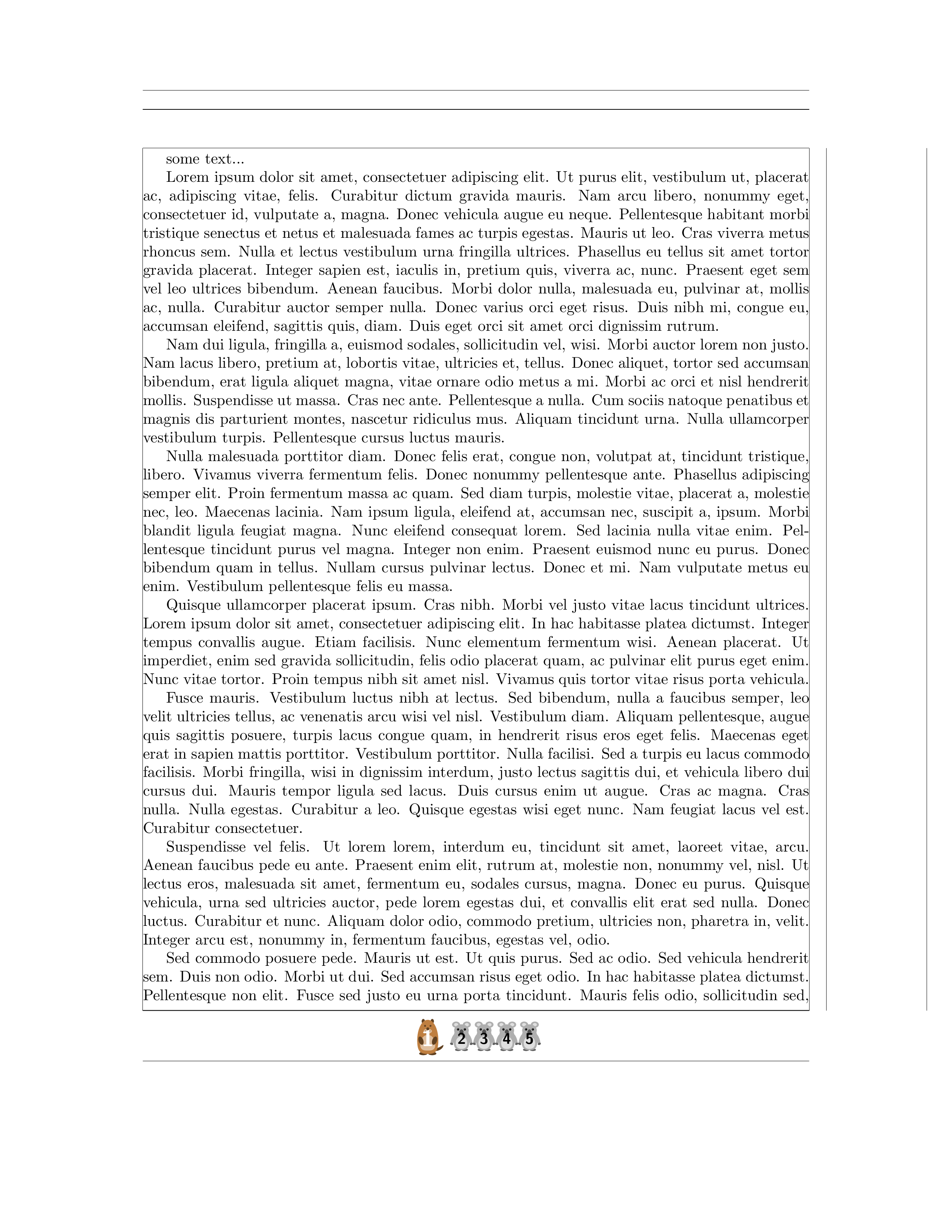
Quiero construir una serie de círculos que se alineen hombro con hombro en cada pie de página. El número de círculos es solo el número de páginas totales, es decir, cada círculo representa una página. En el centro de cada círculo está el número de página actual.
Es fácil lograr esto \foreachsi pgflos diámetros de todos estos círculos son iguales. Sin embargo, quiero que el círculo que representa la página actual tenga un diámetro mayor.
La composición tipográfica es como la figura adjunta producida por el siguiente MWE. ¿Alguien puede ayudarme con esto?
MWE:
\documentclass{article}
\usepackage{fancyhdr,geometry,color,tikz}
\geometry{showframe}
\begin{document}
\pagestyle{fancy}
\fancyhf{}
\renewcommand{\footrulewidth}{0.4pt}
some text...
\cfoot{
\begin{tikzpicture}
\draw[fill=gray,text=white,radius=0.5](0,0)circle node{1};
\draw[fill=red,text=white,radius=1](1.5,0)circle node{2};
\draw[fill=gray,text=white,radius=0.5](3,0)circle node{3};
\end{tikzpicture}
}
\end{document}
Respuesta1
¿Algo como eso?
\documentclass{article}
\usepackage{fancyhdr,geometry,lastpage,refcount,lipsum,tikz}
\geometry{showframe}
\usetikzlibrary{positioning}
\begin{document}
\pagestyle{fancy}
\fancyhf{}
\renewcommand{\footrulewidth}{0.4pt}
some text...
\newcounter{lastpagenumber}%
\setcounter{lastpagenumber}{\getrefbykeydefault{LastPage}{page}{1}}%
\cfoot{\begin{tikzpicture}
\coordinate (cn-0);
\foreach \X [remember=\X as \LastX (initially 0)] in {1,...,\thelastpagenumber}
{\ifnum\X=\thepage
\node[circle,fill=red,text=white,minimum size=1cm,right=0pt of cn-\LastX] (cn-\X) {\X};
\else
\node[circle,fill=gray,text=white,minimum size=0.5cm,right=0pt of cn-\LastX] (cn-\X) {\X};
\fi
}
\end{tikzpicture}
}
\lipsum[1-31]
\end{document}
Por supuesto, se puede personalizar la salida de muchas maneras.
\documentclass{article}
\usepackage{fancyhdr,geometry,lastpage,refcount,lipsum,tikz}
\geometry{showframe}
\usetikzlibrary{positioning}
\begin{document}
\pagestyle{fancy}
\fancyhf{}
\renewcommand{\footrulewidth}{0.4pt}
some text...
\newcounter{lastpagenumber}%
\setcounter{lastpagenumber}{\getrefbykeydefault{LastPage}{page}{1}}%
\cfoot{\begin{tikzpicture}
\coordinate (cn-0);
\foreach \X [remember=\X as \LastX (initially 0)] in {1,...,\thelastpagenumber}
{\ifnum\X=\thepage
\node[circle,draw,thick,font=\sffamily\Large\bfseries,fill=red,text=white,minimum size=1cm,right=0pt of cn-\LastX] (cn-\X) {\X};
\else
\node[circle,draw,font=\sffamily\bfseries,fill=gray,text=white,minimum size=0.5cm,right=0pt of cn-\LastX] (cn-\X) {\X};
\fi
}
\end{tikzpicture}
}
\lipsum[1-31]
\end{document}
Y si encuentras los círculos un poco aburridos, puedes hacer
\documentclass{article}
\usepackage{fancyhdr,geometry,lastpage,refcount,lipsum,tikzducks,tikzlings}
\geometry{showframe}
\usetikzlibrary{positioning,backgrounds}
\begin{document}
\pagestyle{fancy}
\fancyhf{}
\renewcommand{\footrulewidth}{0.4pt}
some text...
\newcounter{lastpagenumber}%
\setcounter{lastpagenumber}{\getrefbykeydefault{LastPage}{page}{1}}%
\cfoot{\begin{tikzpicture}
\coordinate (cn-0);
\foreach \X [remember=\X as \LastX (initially 0)] in {1,...,\thelastpagenumber}
{\ifnum\X=\thepage
\node[font=\sffamily\Large\bfseries,text=white,minimum size=1cm,right=0pt of cn-\LastX] (cn-\X) {\X};
\begin{scope}[scale=0.4,on background layer,shift={(cn-\X.center)},yshift=-3em]
\marmot
\end{scope}
\else
\node[font=\sffamily\bfseries,text=black,minimum size=0.5cm,right=0pt of cn-\LastX] (cn-\X) {\X};
\begin{scope}[scale=0.3,on background layer,shift={(cn-\X.center)},yshift=-3em]
\koala
\end{scope}
\fi
}
\end{tikzpicture}
}
\lipsum[1-31]
\end{document}






